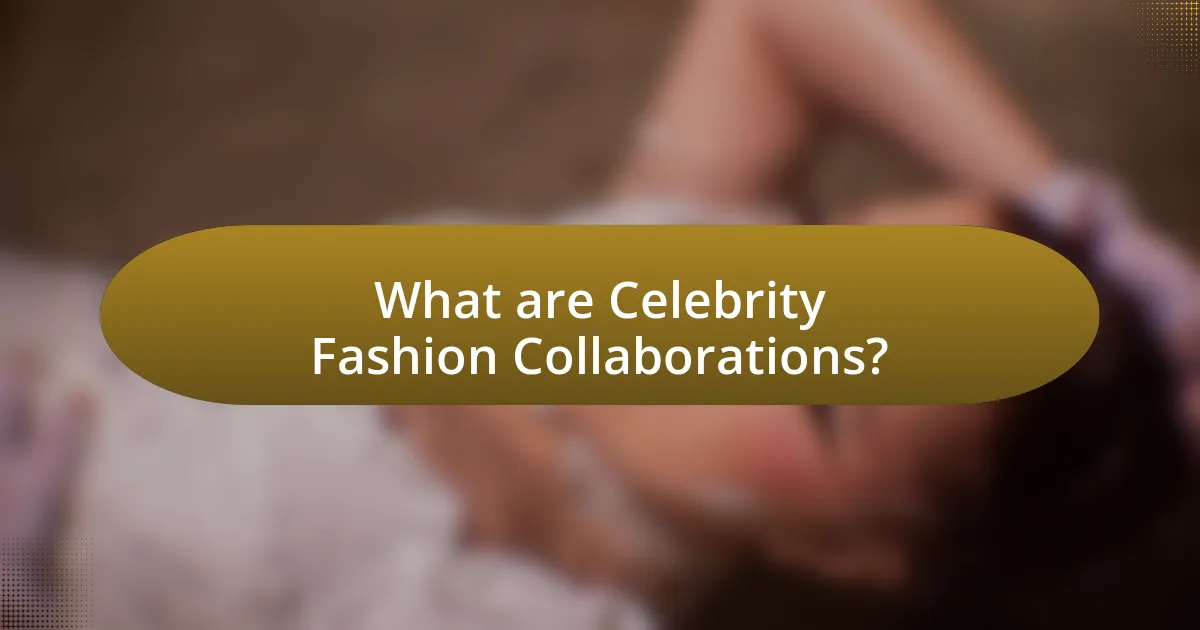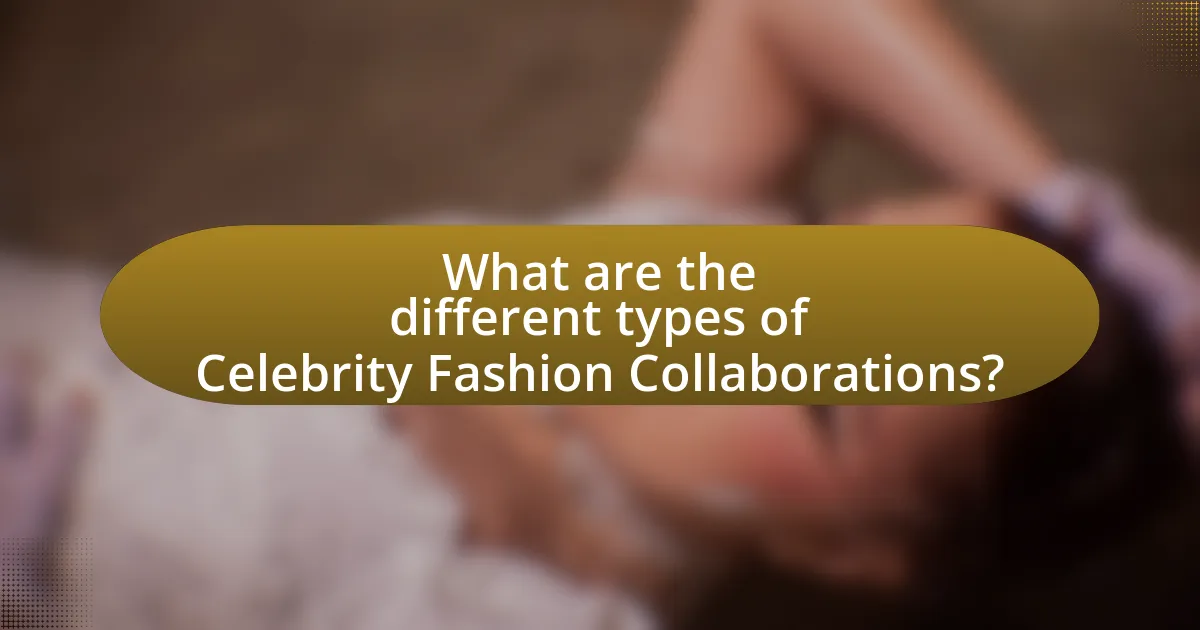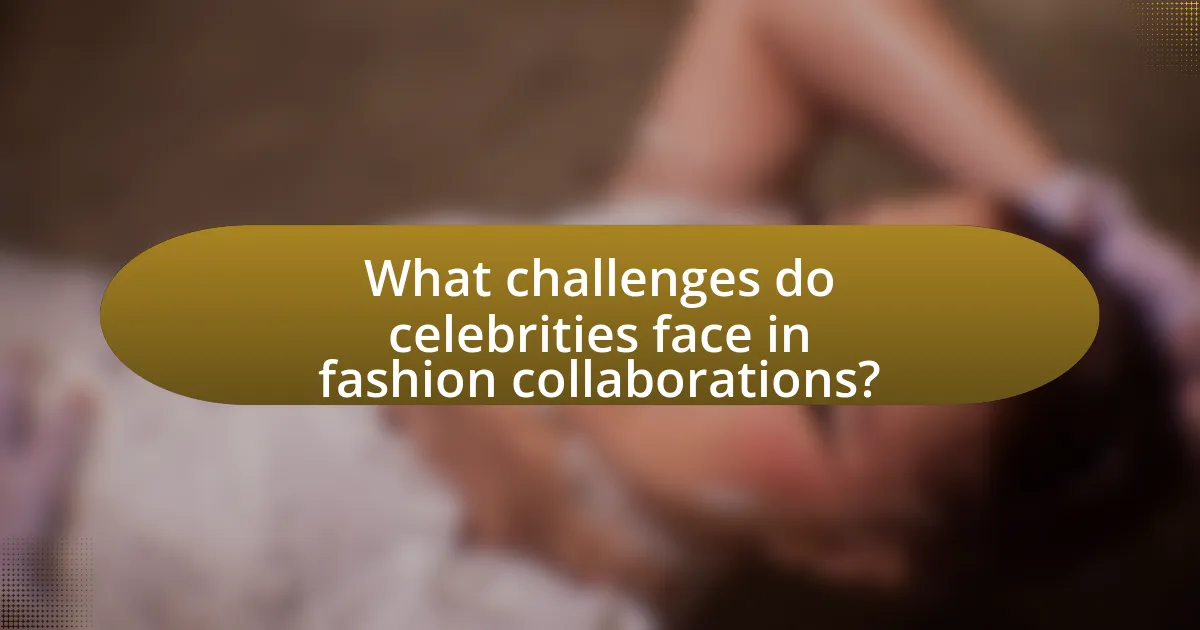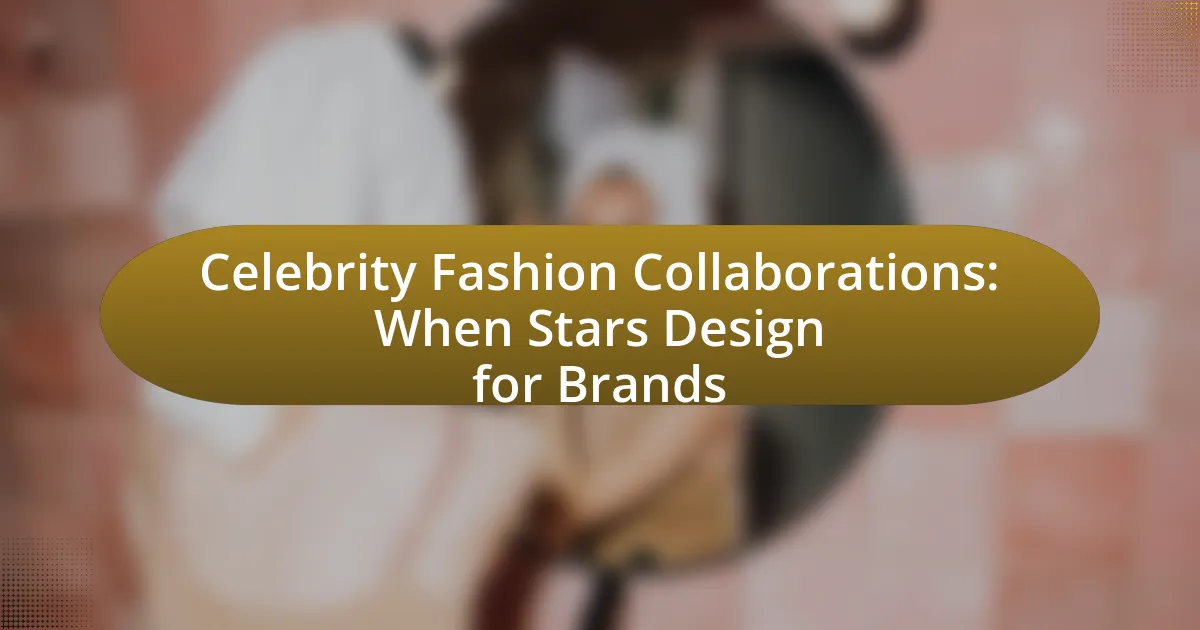Celebrity fashion collaborations are partnerships between celebrities and fashion brands where the celebrity contributes to the design or promotion of a clothing line. These collaborations leverage the celebrity’s influence to enhance brand visibility and appeal, often resulting in limited-edition products that generate significant consumer interest. The article explores how these collaborations work, the roles celebrities play, the selection process for brand partnerships, and the impact on fashion trends. It also discusses the benefits and challenges faced by both celebrities and brands, notable examples in fashion history, and best practices for successful collaborations.

What are Celebrity Fashion Collaborations?
Celebrity fashion collaborations are partnerships between celebrities and fashion brands where the celebrity contributes to the design or promotion of a clothing line or collection. These collaborations leverage the celebrity’s influence and fan base to enhance brand visibility and appeal, often resulting in limited-edition products that generate significant consumer interest. For example, Rihanna’s collaboration with Puma led to the successful Fenty line, which received critical acclaim and commercial success, illustrating the impact of celebrity involvement in fashion design.
How do Celebrity Fashion Collaborations work?
Celebrity fashion collaborations work by pairing a celebrity with a fashion brand to create a unique collection that reflects the celebrity’s personal style and the brand’s identity. These collaborations typically involve the celebrity contributing design ideas, promoting the collection through their platform, and often participating in marketing campaigns. For instance, Rihanna’s collaboration with Puma resulted in the successful Fenty line, which generated significant sales and brand visibility, demonstrating the effectiveness of such partnerships in merging celebrity influence with fashion branding.
What roles do celebrities play in these collaborations?
Celebrities serve as brand ambassadors and creative influencers in fashion collaborations. Their involvement enhances brand visibility and credibility, leveraging their public image to attract consumers. For instance, when Rihanna collaborated with Puma, her celebrity status significantly boosted the brand’s appeal, resulting in a reported 20% increase in sales. Additionally, celebrities often contribute to the design process, infusing their personal style and cultural relevance into the products, which can lead to unique offerings that resonate with fans. This dual role of promoting and designing solidifies their impact in the fashion industry.
How do brands select celebrities for collaborations?
Brands select celebrities for collaborations based on alignment with brand values, target audience appeal, and marketability. The selection process often involves assessing the celebrity’s public image, social media influence, and past collaboration success. For instance, a study by the Journal of Advertising Research found that 70% of consumers are more likely to purchase a product endorsed by a celebrity they admire, highlighting the importance of celebrity appeal in driving sales. Additionally, brands analyze demographic data to ensure the celebrity resonates with their intended consumer base, thereby maximizing the effectiveness of the collaboration.
Why are Celebrity Fashion Collaborations popular?
Celebrity fashion collaborations are popular because they leverage the star power of celebrities to attract consumers and create buzz around fashion brands. These collaborations often result in unique, limited-edition collections that generate excitement and urgency among fans and fashion enthusiasts. For instance, when Rihanna partnered with Puma to launch the Fenty x Puma line, it not only boosted Puma’s sales by 20% but also positioned the brand as a trendsetter in the industry. This phenomenon is supported by the fact that 70% of consumers are more likely to purchase a product endorsed by a celebrity they admire, highlighting the effectiveness of celebrity influence in driving consumer behavior.
What impact do celebrities have on fashion trends?
Celebrities significantly influence fashion trends by leveraging their visibility and cultural impact to shape consumer preferences. Their endorsements and personal styles often lead to increased demand for specific clothing items and brands, as seen with figures like Rihanna and her Fenty line, which revolutionized inclusivity in fashion. Studies indicate that celebrity endorsements can increase sales by up to 20%, demonstrating their power in driving trends and consumer behavior.
How do collaborations benefit both celebrities and brands?
Collaborations benefit both celebrities and brands by enhancing visibility and credibility. Celebrities leverage their influence and fan base to promote the brand, resulting in increased sales and brand awareness. For instance, a study by NPD Group found that celebrity endorsements can lead to a 20% increase in sales for fashion brands. Conversely, brands provide celebrities with a platform to showcase their creativity and expand their reach into new markets, thereby enhancing their personal brand. This symbiotic relationship allows both parties to achieve greater success than they would independently.

What are the different types of Celebrity Fashion Collaborations?
The different types of celebrity fashion collaborations include brand partnerships, capsule collections, and signature lines. Brand partnerships involve celebrities endorsing or promoting existing fashion brands, often resulting in limited-edition products. Capsule collections are curated selections of clothing or accessories designed by celebrities in collaboration with a brand, typically reflecting the celebrity’s personal style. Signature lines are full-fledged fashion lines created by celebrities, showcasing their unique aesthetic and vision, such as Rihanna’s Fenty line with LVMH. These collaborations leverage the celebrity’s influence to drive brand awareness and sales, as evidenced by the significant market impact of successful partnerships like Beyoncé’s Ivy Park with Adidas.
How do limited edition collections differ from ongoing collaborations?
Limited edition collections are unique, time-sensitive offerings that are produced in restricted quantities, while ongoing collaborations involve continuous partnerships between celebrities and brands, resulting in a series of products released over an extended period. Limited edition collections often create urgency and exclusivity, appealing to consumers who seek unique items, whereas ongoing collaborations focus on sustained brand engagement and consumer loyalty through regular product releases. For example, a limited edition sneaker might be available for a short time, while an ongoing collaboration could yield multiple sneaker designs over several seasons, allowing for broader consumer access and brand storytelling.
What are some examples of successful limited edition collections?
Some examples of successful limited edition collections include the collaboration between Rihanna and Puma, which featured the Fenty x Puma line that sold out quickly and received critical acclaim. Another notable example is the collaboration between Kanye West and Adidas, resulting in the Yeezy Boost sneakers, which have consistently generated high demand and resale value. Additionally, the collaboration between Beyoncé and Ivy Park with Adidas launched limited edition activewear that was highly sought after, leading to rapid sellouts. These collections demonstrate the effectiveness of celebrity partnerships in driving consumer interest and sales.
How do ongoing collaborations evolve over time?
Ongoing collaborations evolve over time through a process of adaptation, feedback, and innovation. As celebrities and brands work together, they refine their strategies based on market trends, consumer preferences, and the success of previous collections. For instance, the collaboration between Rihanna and Puma saw significant evolution; initial designs were influenced by streetwear trends, while later collections incorporated more high-fashion elements, reflecting changing consumer tastes and the brand’s positioning. This iterative process is supported by data showing that successful collaborations often lead to increased brand visibility and sales, as seen in the rise of brands like Yeezy, which adapted its offerings based on audience engagement and sales performance.
What are some notable celebrity collaborations in fashion history?
Notable celebrity collaborations in fashion history include the partnership between Rihanna and Puma, which launched the successful Fenty x Puma line in 2015, blending sportswear with high fashion. Another significant collaboration is the collaboration between Kanye West and Adidas, resulting in the Yeezy brand, which has transformed sneaker culture since its debut in 2015. Additionally, the collaboration between Beyoncé and Adidas for Ivy Park has made waves in athleisure since its launch in 2020. These collaborations have not only influenced fashion trends but also generated substantial revenue, with Yeezy reportedly generating over $1 billion in sales by 2019.
Which celebrities have made significant impacts in the fashion industry?
Celebrities such as Rihanna, Kanye West, and Beyoncé have made significant impacts in the fashion industry. Rihanna’s Fenty brand, launched in partnership with LVMH, was the first luxury fashion house created by a woman of color, revolutionizing inclusivity in high fashion. Kanye West’s Yeezy line has transformed streetwear and sneaker culture, achieving a valuation of over $1 billion. Beyoncé’s Ivy Park collaboration with Adidas has emphasized body positivity and diversity, further influencing contemporary fashion trends. These celebrities have not only created successful brands but have also reshaped industry standards and consumer expectations.
What lessons can be learned from past collaborations?
Past collaborations in celebrity fashion demonstrate the importance of aligning brand values with celebrity influence. Successful partnerships, such as Rihanna’s collaboration with Puma, highlight how a celebrity’s personal style can enhance brand identity and attract a dedicated consumer base. Additionally, lessons from failures, like the backlash faced by certain celebrity lines due to lack of authenticity, emphasize the necessity for genuine connection between the celebrity and the brand. These examples illustrate that effective collaborations require strategic alignment, authenticity, and a clear understanding of target demographics to achieve success.

What challenges do celebrities face in fashion collaborations?
Celebrities face several challenges in fashion collaborations, primarily including brand alignment, creative control, and public perception. Brand alignment is crucial, as celebrities must ensure that their personal style and values resonate with the brand’s identity; mismatches can lead to ineffective collaborations. Creative control is another significant challenge, as celebrities often have specific visions that may conflict with the brand’s established aesthetic or marketing strategies. Additionally, public perception plays a vital role; celebrities must navigate the scrutiny of fans and critics, as any misstep can result in backlash or damage to their reputation. These challenges highlight the complexities involved in merging celebrity influence with fashion branding.
How do public perceptions affect celebrity collaborations?
Public perceptions significantly influence celebrity collaborations by shaping brand associations and consumer trust. When the public views a celebrity positively, brands are more likely to engage in collaborations, as this can enhance their image and appeal to consumers. For instance, a survey by Nielsen found that 67% of consumers are more likely to purchase a product endorsed by a celebrity they admire. Conversely, negative public perceptions can lead to backlash, causing brands to distance themselves from certain celebrities to protect their reputation. This dynamic illustrates that public sentiment directly impacts the success and viability of celebrity collaborations in the fashion industry.
What happens when a collaboration does not meet expectations?
When a collaboration does not meet expectations, it can lead to financial losses, damaged reputations, and strained relationships between the involved parties. Financially, brands may experience decreased sales and wasted marketing resources if the collaboration fails to resonate with consumers. Reputationally, both the celebrity and the brand may suffer negative publicity, which can impact future partnerships and consumer trust. Additionally, strained relationships can arise from unmet expectations, leading to potential legal disputes or the end of future collaborations. For instance, a poorly received celebrity fashion line can result in significant inventory markdowns, illustrating the tangible consequences of unmet expectations in such partnerships.
How can celebrities manage their brand image during collaborations?
Celebrities can manage their brand image during collaborations by carefully selecting partnerships that align with their personal values and public persona. This strategic alignment ensures that the collaboration resonates with their audience and maintains authenticity. For instance, when a celebrity known for promoting sustainability collaborates with an eco-friendly brand, it reinforces their commitment to environmental issues, enhancing their brand image. Additionally, celebrities should actively participate in the creative process, ensuring that the final product reflects their style and message. This involvement not only strengthens their connection with the audience but also mitigates the risk of negative backlash. Research indicates that 70% of consumers are more likely to trust a brand when they see a celebrity authentically engaged in the collaboration, highlighting the importance of genuine representation in maintaining a positive brand image.
What are the potential pitfalls of Celebrity Fashion Collaborations?
Celebrity fashion collaborations can face several potential pitfalls, including brand misalignment, quality control issues, and market saturation. Brand misalignment occurs when the celebrity’s image does not resonate with the brand’s target audience, leading to a disconnect that can harm both parties. Quality control issues may arise if the celebrity lacks experience in fashion design, resulting in products that do not meet consumer expectations. Market saturation can happen when numerous celebrities collaborate with brands simultaneously, diluting the uniqueness of each collection and overwhelming consumers. These pitfalls can ultimately affect sales and brand reputation, as evidenced by instances where collaborations failed to achieve anticipated success due to these factors.
How can misalignment between a celebrity and a brand affect a collaboration?
Misalignment between a celebrity and a brand can significantly undermine the effectiveness of a collaboration. When a celebrity’s image, values, or audience do not align with the brand’s identity, it can lead to consumer confusion and distrust. For instance, if a celebrity known for promoting sustainability partners with a fast-fashion brand, it may alienate their fan base and damage the brand’s reputation. Research indicates that 70% of consumers are more likely to trust a brand when its values align with those of the celebrity endorsing it, highlighting the importance of alignment in maintaining brand integrity and consumer loyalty.
What are the risks of overexposure in celebrity collaborations?
The risks of overexposure in celebrity collaborations include brand dilution, audience fatigue, and potential backlash. When a celebrity is involved in too many collaborations, the uniqueness of their brand can diminish, leading to a loss of exclusivity and appeal. For instance, a study by the Harvard Business Review found that excessive celebrity endorsements can lead to consumer skepticism, reducing the effectiveness of marketing campaigns. Additionally, audience fatigue can occur when consumers are overwhelmed by constant celebrity promotions, resulting in decreased engagement and interest. This phenomenon is supported by data indicating that brands with fewer, more strategic collaborations tend to maintain stronger consumer loyalty and brand identity.
What best practices should celebrities follow in fashion collaborations?
Celebrities should prioritize authenticity and alignment with their personal brand when engaging in fashion collaborations. This ensures that the collaboration resonates with their audience and maintains credibility. Additionally, they should conduct thorough research on the brand’s values, target market, and design aesthetics to ensure a cohesive partnership. For instance, Rihanna’s collaboration with Puma successfully reflected her personal style and brand ethos, leading to significant sales and brand loyalty. Furthermore, celebrities should actively participate in the design process, providing input that reflects their vision while also considering market trends. Engaging with fans through social media during the collaboration can also enhance visibility and excitement, as seen with Beyoncé’s Ivy Park line, which generated substantial buzz prior to launch.
How can celebrities ensure authenticity in their collaborations?
Celebrities can ensure authenticity in their collaborations by selecting brands that align with their personal values and style. This alignment fosters genuine connections with their audience, as consumers are increasingly drawn to authenticity in celebrity endorsements. For instance, when a celebrity known for sustainability partners with an eco-friendly brand, it resonates more with their followers, enhancing credibility. Research indicates that 86% of consumers value authenticity in brand partnerships, highlighting the importance of genuine alignment in successful collaborations.
What strategies can enhance the success of a collaboration?
Effective communication is a key strategy that can enhance the success of a collaboration. Clear and open dialogue among all parties involved ensures that expectations, goals, and responsibilities are understood, reducing the likelihood of misunderstandings. Research indicates that teams with strong communication practices are 25% more productive, as highlighted in a study by the Project Management Institute. Additionally, establishing mutual respect and trust among collaborators fosters a positive working environment, which is essential for creative partnerships, particularly in the context of celebrity fashion collaborations where personal branding and artistic vision play significant roles.

Leave a Reply